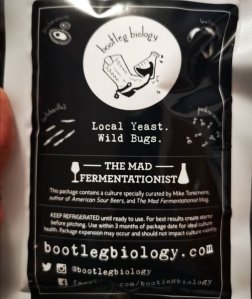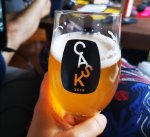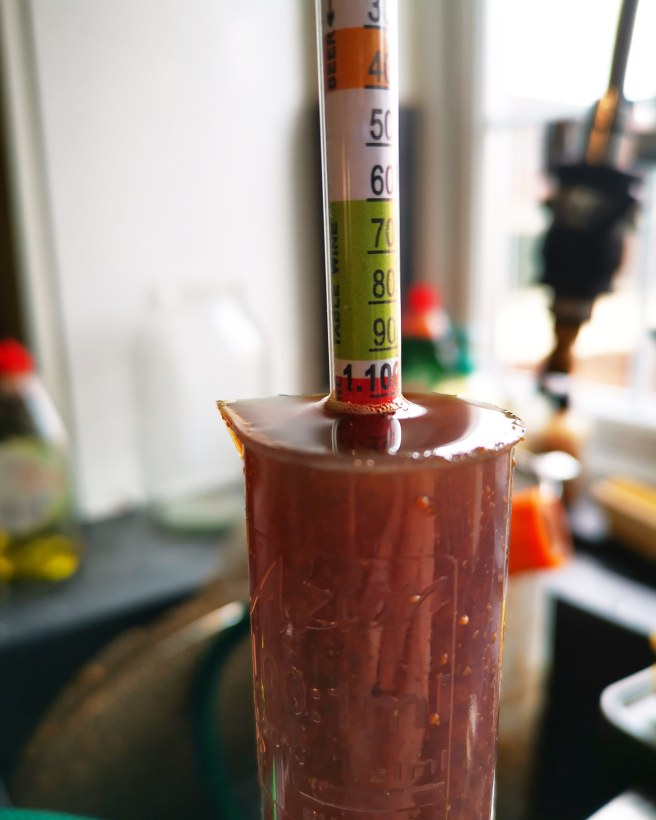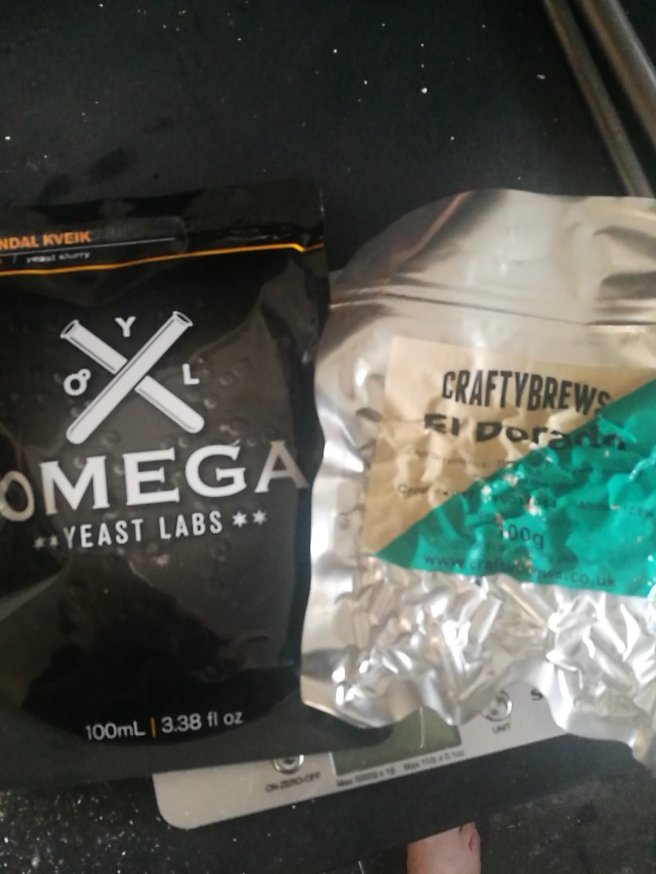It’s nearly the end of the year and the myriad demi-johns I had kicking about my living room has been reduced to two. I have a golden sour which was started as a thing on the Great Brettanomyces Facebook Group. We all brewed the Rare Barrel golden sour recipe but used different yeast strains, I used the Roeselare strain and split the batch between a clean demi-john and a herb liquor barrel. I eventually blended these back together, the demi-john was very earthy and the barrel really zingy so I thought they’d complement. A few months down the line and it needs uplifting with something, it’s just not quite there. So I’ve decided to brew a bergamot wit beer to blend with the golden sour. I have some bergamot tea languishing in the cupboard and I feel like it will add some good and help with the drabness the beer currently has.
The other contains Spontanpeckham, I brewed this in March 2017. I’m hoping to brew another this season and eventually blend them if all goes to plan and they actually taste ok, if not, it was a fun experiment. I’m going to use a Plaato on the next spontaneous, I’m interested in the data output it gives over a longer period.
My freezer and cupboard are full of ingredients I have bought or been given to brew with and just haven’t got around to it. So my new years resolution for 2019 is to get on and use them. Digging around I’ve got some grapes from my neighbour’s garden in the freezer. George next door gave them to me a while ago. He hates the grapevine that is growing next to his shed at the bottom of his garden and had hidden it behind a big board but I spotted it from an upstairs window. This year it has been quite prolific so he passed me a huge bag of plump purple grapes. I think I’m going to do a Kernel Biere de Saison inspired thing.
I also have some chaga which Keith Sowerby generously gave to me when I was in Manchester. I had a chaga brown in Beer Nouveau after he had given it to me and it was a delight so will probably be doing the same thing when I can figure out how to grate the bloody thing!
Other ingredients kicking about in the cupboards are Mahlab (ground cherry kernels often used in middle eastern and greek baking), hibiscus flowers, lapsang tea, sumac, dashi, peanut butter powder and Mike at WIB gave me a kombucha scoby to play with last week. So I best get my thinking cap on!
I’ve finally bottled the Funky Rye. This had been going since September 2017. It had stalled and I blended it with a saison and added cherries and oak to it in August this year. It got down to 1.008 and remained there for 2 months so decided to just bottle the damn thing and be done with.
I’ve also bottled a beer using Omega Yeast American Farmhouse and various hedgerow fruits (blackberries, elderberries, rosehips and rowans). I had split the batch and put the other half on local crab apples but something had gone horribly wrong with that half, it had incredible levels of ethyl acetate and needed to be dumped. The only difference between them were the fruit used so I assume there was something not good on those apples. The beer is currently conditioning in bottles, I’ll probably crack one open in the new year to see how it is coming along.
The last beer I bottled recently was my megablend. I added pomegranate molasses and golpar (Persian hogweed) to it, I opened one last week and it had massive amounts of THP in it, it’s just liquid breakfast cereal. I’m quite sensitive to THP so this may just be me but I’m going to sit on them a while longer to let that disappear. More info on THP here
Next year I’d like to use more foraged fruits. I know there are Mulberries near my house and I have recently come across some medlars. I’d also like to try more fruit powders, Black Bretty turned out quite well so I’m definitely going to look into using some more (I pick these up at Spice Mountain in Borough Market if you’re interested).

And lastly because we should all bask in our own glory once in a while, I came 2nd in the Brett, Sours and Bugs category at Brewcon this year, hooray. I’m very happy with my scores, I was a little worried my beers would not be carbonated in time but something magic must have happened in the weeks from drop off to judging day! These beers take a lot of patience to make and to be recognised for them is amazing. It’s also nice to let other people try my beer and not just horde them in my house to myself. Big thanks to Simon Pipola for organising the event, it’s a huge undertaking and I’m amazed he hasn’t crumbled into a million pieces (note to everyone: we must clone him). I had a great time on the day; it was really good to meet other homebrewers who I had only really spoken to online before. This year there seemed to be more from outside London which is great. The homebrew community in the UK is growing and that’s very exciting.


 Apologies reader but I have been neglecting this blog. I got ill last year which took out a chunk of my usual brewing time but I’m fine now and, as of the start of 2020, I no longer work on Wednesdays. Hooray! This means I have ample time to brew, so no excuses.
Apologies reader but I have been neglecting this blog. I got ill last year which took out a chunk of my usual brewing time but I’m fine now and, as of the start of 2020, I no longer work on Wednesdays. Hooray! This means I have ample time to brew, so no excuses.

 At Christmas Water Into Beer homebrew club had a lucky dip challenge where a malt, yeast and hop were picked out and we had to brew something with them. I wasn’t present for mine and I forgot to pick them up til a month later. I got Biscuit malt, New World Strong Ale yeast and Ekuanot. Sooo my first thought was BARLEYWINE.
At Christmas Water Into Beer homebrew club had a lucky dip challenge where a malt, yeast and hop were picked out and we had to brew something with them. I wasn’t present for mine and I forgot to pick them up til a month later. I got Biscuit malt, New World Strong Ale yeast and Ekuanot. Sooo my first thought was BARLEYWINE.





